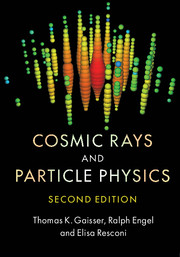Book contents
- Frontmatter
- Contents
- Preface to the first edition
- Preface to the second edition
- 1 Cosmic rays
- 2 Cosmic ray data
- 3 Particle physics
- 4 Hadronic interactions and accelerator data
- 5 Cascade equations
- 6 Atmospheric muons and neutrinos
- 7 Neutrino masses and oscillations
- 8 Muons and neutrinos underground
- 9 Cosmic rays in the Galaxy
- 10 Extragalactic propagation of cosmic rays
- 11 Astrophysical γ -rays and neutrinos
- 12 Acceleration
- 13 Supernovae in the Milky Way
- 14 Astrophysical accelerators and beam dumps
- 15 Electromagnetic cascades
- 16 Extensive air showers
- 17 Very high energy cosmic rays
- 18 Neutrino astronomy
- Appendix
- References
- Index
18 - Neutrino astronomy
Published online by Cambridge University Press: 05 June 2016
- Frontmatter
- Contents
- Preface to the first edition
- Preface to the second edition
- 1 Cosmic rays
- 2 Cosmic ray data
- 3 Particle physics
- 4 Hadronic interactions and accelerator data
- 5 Cascade equations
- 6 Atmospheric muons and neutrinos
- 7 Neutrino masses and oscillations
- 8 Muons and neutrinos underground
- 9 Cosmic rays in the Galaxy
- 10 Extragalactic propagation of cosmic rays
- 11 Astrophysical γ -rays and neutrinos
- 12 Acceleration
- 13 Supernovae in the Milky Way
- 14 Astrophysical accelerators and beam dumps
- 15 Electromagnetic cascades
- 16 Extensive air showers
- 17 Very high energy cosmic rays
- 18 Neutrino astronomy
- Appendix
- References
- Index
Summary
Because neutrinos interact only by the weak interaction, a large target volume is necessary to detect them. This is especially true in the case of naturally occurring neutrinos where the flux is low compared to neutrinos from an accelerator beam or from a nuclear reactor. The idea of using a large volume of clear water to detect neutrinos was proposed in 1960 by Greisen [538], Reines [693] and Markov [694]. The Cherenkov light from charged particles produced by interactions of neutrinos would be detected by optical modules in the water, visible from a long distance. Reines distinguished between cosmic neutrinos (by which he meant neutrinos of astrophysical origin) and cosmic ray (i.e. atmospheric) neutrinos. He writes that interest in the possibility of detecting cosmic neutrinos “stems from the weak interaction of neutrinos with matter, which means that they propagate essentially unchanged in direction and energy from their point of origin (except for the gravitational interaction with bulk matter, as in the case of light passing by a star) and so carry information which may be unique in character.” In the same volume of Annual Reviews, Greisen proposed to use a large volume of water in a mine to detect astrophysical neutrinos. Markov proposed using the deep ocean or water in a lake to study atmospheric neutrinos.
The idea developed in two ways. The first, originally motivated by the goal of detecting proton decay, led to the relatively densely instrumented detectors in deep mines, IMB and Kamiokande, which detected the burst of ≈10 MeV neutrinos from SN1987A [401, 403] and set limits on stability of the proton. The second-generation water detectors Super-Kamiokande and SNO (Sudbury Neutrino Observatory) were designed in large part for high-resolution measurements respectively of atmospheric and of solar neutrinos. Super-K confirmed oscillations of atmospheric neutrinos [59] as the cause of the anomalous ratio of νμ/νe found earlier by Kamiokande and IMB. It also set stronger limits on proton decay. SNO, filled with heavy water, measured neutral current interactions of all flavors of neutrinos from the Sun, as well as charged current interactions of νe, thereby confirming oscillations as the explanation of the solar neutrino problem [233, 695].
The other path was motivated by the goal of using high-energy neutrinos as a probe of cosmic ray origin.
- Type
- Chapter
- Information
- Cosmic Rays and Particle Physics , pp. 356 - 373Publisher: Cambridge University PressPrint publication year: 2016

